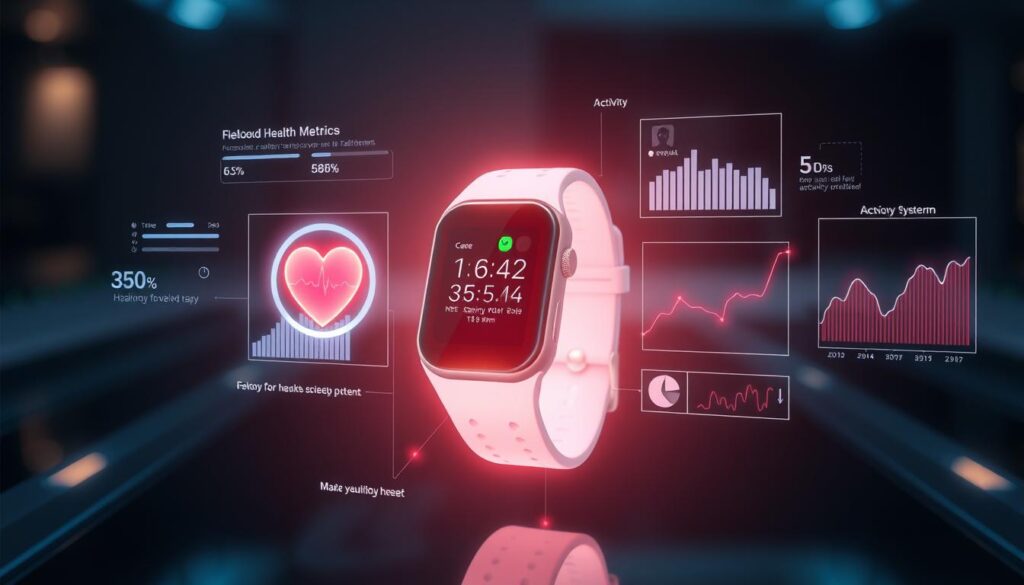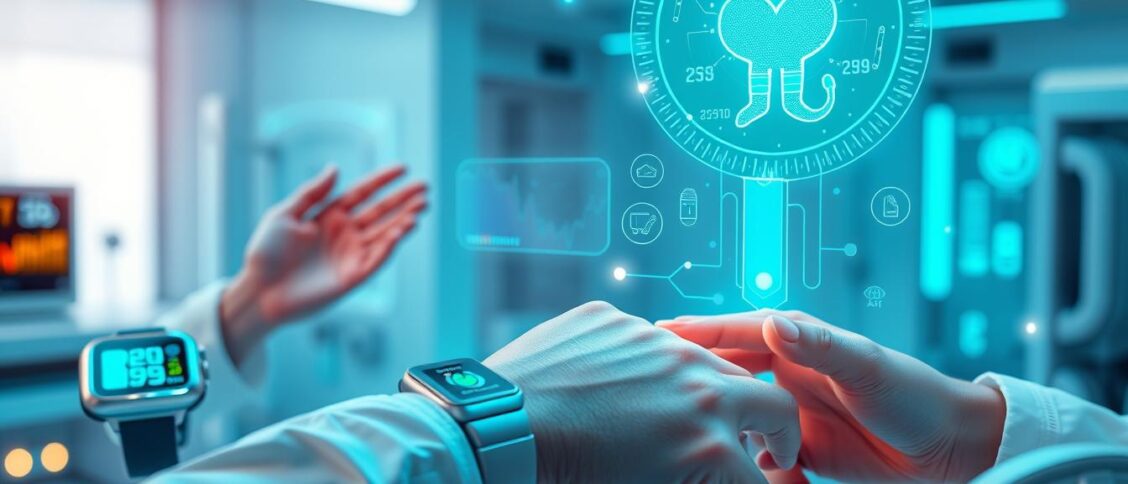Could AI change the game in fighting non-communicable diseases worldwide? With the wearable tech market set to soar to $161 billion by 2033, AI’s role in healthcare wearables marks the start of a new era. This growth is driven not only by fashion but by the promise of saving lives.
Today, there’s a huge gap in healthcare staffing that could reach almost 250,000 posts by 2030 within NHS trusts alone. AI in wearables could help fill this gap, offering new ways to monitor health like never before. Diseases that lead to three out of four deaths globally could be monitored continuously with AI wearables.
Through advanced sensors, intelligent tracking offers a detailed health view. It also uses AI for analysis right on local devices, thanks to edge computing. This cuts down the need for cloud servers. Special chips make these devices efficient and lower in power usage. They make healthcare monitoring better and cheaper over time by simplifying designs and supply chains.
AI wearables not only improve diagnosis but also push the healthcare industry towards digital change. Big companies like Microsoft, Apple, and Google Health see its huge potential. In today’s digital age, the chance to get personalised health data is as easy as checking a wristwatch.
The Digital Transformation in Healthcare and Rise of Wearable Technology
The healthcare sector is seeing big changes because of digital growth. This is hugely due to the rise of wearables like smartwatches. These changes are altering both the delivery and experience of healthcare. Now, wearables are at the heart of modern medicine.
Sector Growth and Market Predictions
Studies show the healthcare wearables market is set to grow by 97% to $161 billion by 2033. This leap is driven by improvements in the tech, making wearables more engaging and useful. They track health non-stop, improving treatments and results. This shift makes a big mark on the economy of the healthcare sector.
Benefits of Continual Health Monitoring on Wearables
Wearables offer constant monitoring, tracking things like heart rate and blood sugar. This is great for looking after patients directly and for collecting important health data. It supports a preventative approach to health, helping avoid hospitals by catching issues early.
Practical Applications in Everyday Healthcare
It’s not just about counting steps. Wearables are now used for many health aspects, like tracking fertility and heart conditions. They help tailor care to each person, offering data that guides treatment. Adding AI to these devices has raised their value, turning them into key players in managing health.
Advances in Vital Signs Tracking and the Importance of AI Algorithms
AI algorithms have changed how we track vital signs for the better. With wearable sensors, these smart algorithms analyse data in depth. This boosts the precision and speed of health checks in real time. Research highlights AI’s key role in making devices more effective, especially in keeping an eye on patients and studying sweat.
New studies show a futuristic system linking wearable sensors with AI. This combo improves how we gather data. It also opens doors to new discoveries in sports and health. Special networks for healthcare prove how crucial strong systems are for sophisticated health apps.
AI’s smart analysis offers predictions that help doctors make better decisions. It’s all about custom treatments that boost recovery and make sure everyone gets the care right for them. Wearable tech collects plenty of health info, and AI uses it to fine-tune treatment, reducing risks and improving results.
Today, vital signs tracking with AI and wearable sensors is more than just a tech leap. It’s a vital asset, moving healthcare towards being more tailored, swift, and effective.
Wearable Technology and the Shift Towards Preventive Care
Wearable tech is leading the way to focus more on stopping diseases before they start. It’s a big help in the fight against serious diseases. This type of technology helps spot diseases early. It could lessen the worldwide illness load a lot.
Conditions like heart disease, cancer, lung problems, and diabetes are huge killers globally. Using tech to manage these can create better ways to deliver health care.
Wearable tech works well with the Internet of Medical Things (IoMT). It makes sharing data easy and gets patients more involved. Health providers can now offer care that’s more suited to the individual’s needs early. It means a big shift towards being proactive about health.
Using this tech helps catch health problems early and manage long-term diseases better. The big bonus is spotting possible health issues early on.
Combatting Non-Communicable Diseases with Early Detection
Wearable devices use smart sensors and algorithms to watch health signs closely. This is key for finding diseases early. It gives important data that can warn about a health problem before it gets worse.
Big companies like Microsoft, Apple, and Samsung are putting a lot into this tech. They see its power to change health care by cutting down on hospital visits and costs a lot.
Patient Engagement and Management through Wearables
Patient involvement is a main part of modern preventive care thanks to wearable tech. These devices let people know their health status. It motivates them to look after their health better. This is vital for dealing with long-term health issues.
Devices give immediate feedback and warnings to help patients manage their health actively. Now, about 88% of health providers are getting these gadgets, showing a big increase and dedication to using remote patient monitoring regularly.
For a deep dive into how AI is changing customer services in many areas, including health, check out this article on AI in customer.
Enhancing Remote Monitoring with Edge Computing and AI
Edge computing and AI have truly transformed healthcare’s remote monitoring. They bring a new way to handle patient data safely and quickly. Working right on the device, edge computing cuts the need for too much internet bandwidth and makes patient data safer. This quick, local data processing is key for watching health in real-time. It’s really important for places without much internet, helping everyone get good healthcare, no matter where they are.
By combining Mobile Edge Computing (MEC) and 5G, remote monitoring gets much faster and smoother. This is super important in emergencies where every moment matters. These tech advances make Internet of Medical Things (IoMT) devices work better. They also keep health info very secure through top-notch encryption and security steps. MEC and 5G make things work better, save money, and help in medical emergencies.
AI’s role in healthcare also shines with AI-driven analytics in wearables and sensors. They keep an eye on health stats like blood pressure and heart rates, turning simple numbers into helpful advice. This smart system doesn’t just store data. It closely examines it, helping make quick and smart health choices. This moves healthcare from just reacting to problems to preventing them.
Studies also show how AI and edge computing are great for specific health needs, like stopping diseases before they start and handling chronic conditions. This smart mix makes healthcare better by processing data instantly. This makes treatments tailored and timely.
As AI and edge computing keep getting better, healthcare providers will have much stronger tools. These tools will not only keep patient data safe but also improve how care is given from afar. This tech is paving the way for a future where healthcare is easy to reach, quick, and more effective, changing how we take care of people everywhere.
Fitness Devices as a Portal to Personalised Health Insights
Fitness gadgets have come a long way since the 1990s. Starting as simple step counters, they’ve grown into advanced tools for health monitoring. Now, they play a key part in improving how we manage our health. They use analytics on health data to offer custom tips for a healthier life.

Their hook-up with mobile tech has changed the game. These gadgets connect with apps on our phones for better interaction. Thanks to this, personalized fitness and health plans are easy to get and adapt to what we need. This shows the true power of merging them with mobile tech.
Data Analysis for Tailored Fitness and Wellness Programs
These smart devices analyse the data we give them. They then suggest fitness plans and health advice just for us. They keep us motivated by tracking our achievements. Plus, they’re key in helping to prevent health issues. Devices like the Apple Watch and Garmin Vivosport are great at this. They watch over our hearts and overall health.
Integration with Mobile Technology and Apps
Linking fitness gadgets with our mobiles brings a more connected way to look after our health. We get health updates straight to our phones, helping us act fast. This encourages us to be more mindful about our health every day.
To wrap up, fitness devices joining forces with mobile apps and health data analysis is a big step forward. It doesn’t just help us meet our health goals. It’s also vital for improving health all around the world. Thanks to this, keeping an eye on our health has never been easier.
Powering Advanced Healthcare Wearables: The Role of Specialised Chips
Application-specific integrated circuits (ASICs) are changing healthcare wearables. They are expected to push the market to USD 161 billion by 2033. ASICs improve performance and energy use, key for wearables tracking health non-stop. These chips help wearables work longer without needing to be charged often.
ASICs: Balancing Power Efficiency and Performance
ASICs are made for wearable technology’s specific needs. They ensure devices are power-efficient and perform well. These chips are vital for sensors that check things like heart rate and blood sugar all the time. They support a wide range of healthcare needs, from long-term illness care to urgent health warnings.
Overcoming Engineering Challenges in Wearable Designs
Making ASICs for wearables means solving many technical issues, especially making things smaller and managing heat. Fitting sophisticated circuits into tiny spaces shows the tough work engineers do. This makes wearables easier to use and wear. Advances also cut costs and energy use, leading to greener manufacturing.
AI in Healthcare Wearables: Real-time Analysis and Personalised Treatments
The arrival of AI in healthcare wearables has changed how we monitor health in real time, leading to precise medical actions. These AI-powered treatments provide quick diagnoses, which are vital for handling conditions like heart diseases. AI’s blend with wearables boosts the analysis of health and tailors treatment plans for each person’s unique needs.
During the COVID-19 pandemic, the importance of AI in wearables became clear. They helped track symptoms and forecast outcomes for patients. These gadgets are evolving into smart systems that combine advancements in electronics and photonics. They use AI to analyse health data, offering personalised advice and helping manage long-term conditions more effectively.
Technologies like Integrated Personal Health Monitoring Systems (IPHMS) show how AI can improve monitoring patients remotely. These systems gather and process different types of health data. Through detailed AI analysis, they provide real-time updates and tailored health advice. These alerts and insights from the systems improve medical care by using precise health data.
AI in wearables, such as smartwatches, does more than just track health. It also considers behaviour and the environment to make healthcare even more personalised. AI will lead the future of healthcare wearables, making the monitoring and treatment of health conditions more accurate and tailored to each patient.
The growth of these AI tools marks a significant move towards better and preventive healthcare. As these technologies advance, they will greatly enhance how healthcare is delivered and how patients are involved. This promises a future where healthcare meets the individual’s needs closely, instantly, and in a more tailored way.
Patient-Centric Healthcare: Enhancing the User Experience with AI
In healthcare today, making the user experience better with a patient-focused approach is a real goal. It’s made possible by using AI in healthcare. This move to include technology has changed how we care for patients, making interactions more helpful and simple. AI helps facilities offer a more personal and effective service.
Importance of User Interface and Accessibility in Wearable Devices
For wearable tech in healthcare, having an easy-to-use interface and being accessible is crucial. These devices, powered by smart AI, are made to be easy to understand. This means crucial health info is easy to find for users. AI doesn’t just make using devices simpler; it also makes them more accessible for everyone, including those with disabilities or who aren’t tech-savvy.
Improving Patient-Doctor Communication through Data Sharing
Good communication in healthcare gets a big boost from AI. AI makes sharing data between patients and doctors easy, helping to make better treatment plans. This access to real-time data keeps patient information up-to-date. This is key for watching health closely and spotting problems early.
AI can predict health issues in wearables, alerting doctors before things get worse. This way, AI not only aids in handling health conditions but also keeps patients in the loop about their health journey.
AI’s role in healthcare is getting bigger, giving us strong options for care tailored to each patient and smoother communication. As seen in a recent study, advanced AI in CRM systems is vital for making decisions based on data and engaging with patients personally in the United Kingdom. For more info, check out optimising client relations with AI-powered CRM.
AI Algorithms: Transformative Predictive Models in Healthcare
AI algorithms play a big role in making better predictive models in healthcare. They help spot diseases early and set up early warning systems. With AI, these models have become key in improving how patients fare and changing clinical ways.
Predictive Analytics and Early Warning Systems
AI-based predictive analytics are crucial for early warning systems in healthcare. They quickly spot and manage health issues. AI is good at diagnosing diseases through looking at lots of data. This way, it can warn about health risks before they get serious.
AI also helps in watching and guessing how diseases like diabetes and cancer will go. This makes the treatments given to patients more exact.
Case Studies: Wearables Impacting Clinical Research and Patient Outcomes
Recent studies show how AI in wearables really changes clinical research and patient care. These devices keep an eye on health signs all the time. They can spot problems like odd heart rhythms early. This not only makes clinical research better but also adds predictive analytics. This is key for looking after patients before problems grow.
With AI, there are big steps forward in diagnosing and managing chronic diseases. There are now smarter ways to handle diabetes and improve patient care. AI has been crucial in these areas, offering better tools for dealing with diseases and predicting outcomes.
To learn how AI strategies are helping in better understanding customer groups and changing marketing, read (AI for Better Customer Segmentation). This shows how AI’s smart tools are also useful in healthcare’s predictive models, showing AI’s wide use in different fields.
Conclusion
AI is changing medical technology through healthcare wearables. These devices are getting better at tracking vital signs, thanks to AI. This means big improvements for both users and the medical field. AI in wearables is changing how we look after patients. It offers instant analysis and helps prevent illnesses, especially those causing many deaths worldwide.
More and more people are using e-health tools, showing how important wearables have become. People think the benefits of these technologies outweigh the risks. The market for wearable AI is expected to grow quickly. This is due to smarter AI algorithms and devices that monitor patients from afar.
The use of AI in wearables is set to keep rising. Their impact on healthcare will get even bigger. But, it’s key to keep focusing on what patients need. This includes better medical results and dealing with issues like privacy and the need for real doctors in treatment plans. Wearable technology is paving the way to make healthcare more available to everyone. It allows people to easily check their health. Soon, healthcare will be a normal part of our daily life, thanks to wearable AI.
FAQ
How is AI being utilised in advanced healthcare wearables?
AI is used in healthcare wearables by combining smart sensors and tracking tech. These tools gather data on heart rate, sleep, and activity. AI analyzes this info to provide custom health advice and warnings.
What does the digital transformation in healthcare signify for wearable technology?
The digital shift in healthcare means a move towards using data more in wearables. It’s about making devices that constantly check health, gather information, and use data to help keep patients healthy.
How has the healthcare wearables market evolved, and what are the projections for its growth?
The healthcare wearables market has grown quickly due to new technology and a growing interest in health tracking. By 2025, it might grow to around 0 billion. This is thanks to ongoing innovation and more people using these devices.
What are the main benefits of continuous health monitoring on wearables?
Continuous monitoring lets you track your health in real time and spot problems early. It makes patients more involved and helps them make smart health choices. This can improve how diseases are managed and lead to better health overall.
Can you provide examples of how wearable technology is applied in everyday healthcare?
Sure. Fitness trackers check how much you move. Smartwatches monitor your heart rate and let you know if something’s wrong. Devices can also follow your sleep or check your blood sugar. Some help with recovery by watching your movement.
Why are AI algorithms essential in vital signs tracking?
AI is key for tracking because it can handle complex health data. It spots patterns or issues in the data. This helps doctors diagnose quicker, which means better care and faster action.
How is wearable technology contributing to preventive care?
Wearables help with early disease detection. By monitoring signs of illness early, they can prevent diseases from getting worse. They aim to stop illnesses before they start, not just treat them after they appear.
How is wearing technology being used in the management of non-communicable diseases (NCDs)?
Wearables manage NCDs by keeping an eye on important health signs. For example, monitoring blood pressure or glucose. This real-time data helps with quick action and better disease management.
In what ways does wearable technology enhance patient engagement and management?
Wearables let people watch their health closely. They can set goals, see their progress, and get feedback. This makes them more active in their health care and strengthens their work with doctors.
What role does edge computing play in the context of enhancing remote patient monitoring with AI?
Edge computing is vital because it processes data on the device itself. This cuts down delay and keeps data safe. It lets advanced AI work instantly, improving how we watch over patients from afar.
How do fitness devices serve as portals to personalised health insights?
Fitness devices use AI to look at your health data. They give advice tailored to your goals and health. They’re like personal health guides, giving insights to help with fitness and wellness.
Why are ASICs important in healthcare wearables and how do they contribute to device performance and longevity?
ASICs make healthcare wearables work better and last longer. They’re made for specific tasks, which saves power and makes devices more reliable. This is key for wearables that monitor health all the time.
How do AI-powered treatments in healthcare wearables aid in real-time health analysis?
AI treatments in wearables quickly understand health data. This means they can offer custom care right when needed. The result? More effective treatments for patients.
What aspects of user experience are enhanced by AI in patient-centric healthcare wearables?
AI improves wearables by making them easier and more personal to use. It simplifies how you see and understand health data. This makes managing your health more fun and effective.
How is patient-doctor communication being improved through data sharing from AI-enhanced wearables?
Sharing data from wearables makes talking to doctors better. It ensures that doctors have up-to-date health info. This leads to smarter health decisions and clearer discussions about care.
What is the impact of predictive analytics and early warning systems in healthcare?
These systems greatly affect healthcare by spotting health concerns early. This can lead to quicker actions, better patient results, and lower health care costs.
Can you provide examples of how wearables have impacted clinical research and patient outcomes?
Wearables offer valuable data over time for studies, help with remote monitoring in trials, and support new treatments. They’ve helped with better chronic disease management, recovery after surgery, and improved patient involvement for healthier lifestyles.
Source Links
- The Future of Healthcare: AI, Wearable Technology, and the Role of ASICs | EnSilica – https://www.ensilica.com/news/the-future-of-healthcare-ai-wearable-technology-and-the-role-of-asics/
- Artificial intelligence in healthcare: transforming the practice of medicine – https://www.ncbi.nlm.nih.gov/pmc/articles/PMC8285156/
- Digital Transformation in Healthcare: Technology Acceptance and Its Applications – https://www.ncbi.nlm.nih.gov/pmc/articles/PMC9963556/
- The rise of patient empowerment through wearable devices – Intelligent Health.tech | Latest News and Analysis in Health – https://www.intelligenthealth.tech/2024/03/20/the-rise-of-patient-empowerment-through-wearable-devices/
- The Emergence of AI-Based Wearable Sensors for Digital Health Technology: A Review – https://www.mdpi.com/1424-8220/23/23/9498
- The Emergence of AI-Based Wearable Sensors for Digital Health Technology: A Review – https://www.ncbi.nlm.nih.gov/pmc/articles/PMC10708748/
- Harnessing the Power of AI: A Comprehensive Review of Its Impact and Challenges in Nursing Science and Healthcare – https://www.ncbi.nlm.nih.gov/pmc/articles/PMC10744168/
- Wearable Technology in Healthcare and Its Benefits – https://kms-healthcare.com/blog/wearable-technology-in-healthcare/
- Wearable Technology in Healthcare: The Future of Medical Devices – https://topflightapps.com/ideas/wearable-technology-in-healthcare/
- Enhancing patient healthcare with mobile edge computing and 5G: challenges and solutions for secure online health tools – Journal of Cloud Computing – https://journalofcloudcomputing.springeropen.com/articles/10.1186/s13677-024-00654-4
- Wearable Health Technology: From Fitness Trackers to Life-Saving Medical Devices | 7Med Integration – https://7med.co.uk/wearable-health-technology-evolution/
- Wearable Health Technology and Electronic Health Record Integration: Scoping Review and Future Directions – https://www.ncbi.nlm.nih.gov/pmc/articles/PMC6746089/
- How Wearable Devices and Wellness Apps Are Revolutionizing Wellness Technology – https://blog.corehealth.global/tech-for-wellness-how-wearable-devices-and-wellness-apps-are-revolutionizing-self-care
- The Future of Healthcare: AI, Wearable Technology, and the Role of ASICs – https://www.linkedin.com/pulse/future-healthcare-ai-wearable-technology-role-asics-ensilica-apbme?trk=public_post_main-feed-card_feed-article-content
- The rise of artificial intelligence in healthcare applications – https://www.ncbi.nlm.nih.gov/pmc/articles/PMC7325854/
- Personalized Health Monitoring Systems Integrating Wearable and AI – https://www.scirp.org/journal/paperinformation?paperid=132006
- AI-powered Wearables and Remote Patient Monitoring: The Future of Personalized Healthcare – https://www.linkedin.com/pulse/ai-powered-wearables-remote-patient-monitoring-future-santosh-g-60tdc
- Navigating the Future: The Transformative Impact of Artificial Intelligence on Hospital Management- A Comprehensive Review – https://www.ncbi.nlm.nih.gov/pmc/articles/PMC10955674/
- Top 8 AI Use Cases in Healthcare for Driving Patient Engagement and Enhancing Patient Experience – https://kanini.com/blog/how-is-artificial-intelligence-ai-transforming-patient-engagement/
- The Transformative Power of AI in Healthcare – https://www.ahead.com/resources/the-transformative-power-of-ai-in-healthcare/
- The Role of AI in Hospitals and Clinics: Transforming Healthcare in the 21st Century – https://www.ncbi.nlm.nih.gov/pmc/articles/PMC11047988/
- Wearable AI Technologies & Their Impact on Healthcare – https://www.xevensolutions.com/blog/wearable-ai-technologies-in-healthcare/
- Patients’ views of wearable devices and AI in healthcare: findings from the ComPaRe e-cohort – npj Digital Medicine – https://www.nature.com/articles/s41746-019-0132-y
- The Evolution of Wearables and the Impact of AI on Personalized Digital Health Solutions. – https://www.linkedin.com/pulse/evolution-wearables-impact-ai-personalized-digital
Discover more from Scott Dylan
Subscribe to get the latest posts sent to your email.






